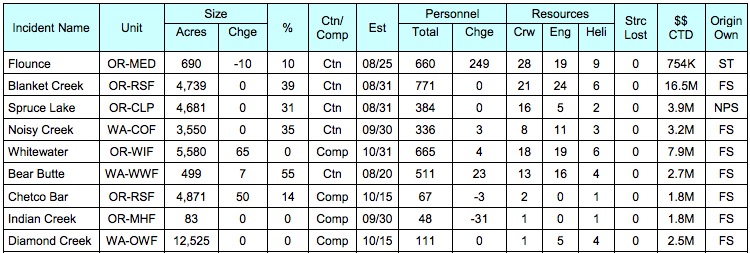Above: Firefighters on the Liberty Fire in Montana, which is being managed using a less than full suppression strategy. Photo by Kari Greer.
(Originally published at 4:05 p.m. MDT August 10, 2017)
When we saw today that additional evacuations were required on the Sunrise Fire six miles south of Superior, Montana, a fire that is not being fully suppressed, we wondered how many fires are in that same less than full suppression category.
The table at the top of the national Incident Management Situation Report for August 10 (which uses data submitted the evening before) lists the number of uncontained large fires, but an asterisk leads to a note saying, “*Uncontained large fires include only fires being managed under a full suppression strategy.” The report today lists 24 large uncontained fires. After going through the 12-page document we found 13 other large fires that are not being fully suppressed, which is 35 percent of the 37 total large fires.
Unless you study the deciphering document about how to read the report, it is not obvious that any fires are not being fully suppressed. The column heading “Ctn/Comp” is the key. “Ctn” indicates the fire is being fully suppressed or contained, while “Comp” fires are not. Those codes are related to the column to the left which has a number referring to the percent contained (Ctn), or, the percent of the incident objectives that are complete (Comp) such as monitor, confine, or point zone protection on less than full suppression fires.

Today’s report lists seven fires in the Northern Rockies Geographic area that are less than full suppression, the Northwest Area has five, and there is one in Northern California.
These 13 fires have burned approximately 99,000 acres, have 4,336 personnel assigned, and have cost about $79 million to date. The number of personnel is 28 percent of the total on all active uncontained fires, and the acres burned is 10 percent of the total.
The average “completion” for the 13 let burn less than full suppression fires is 19 percent. Most of them have estimated completion dates of late September to sometime in October.
Land managers who implement this strategy will tell you they want to restore fire to the landscape in an area where it has been unnaturally excluded, thereby enhancing the environment for plants and animals — and people if it occurs near a wildland/urban interface. Reducing the vegetation, or fuels, can make it easier to suppress the next fire in the same area, perhaps resulting in fewer structures being destroyed. On fires like this they may completely stop the spread where it could damage private property, while only observing it or in some cases encouraging it to burn in more remote locations. The Incident Management Team on the Sunrise Fire included this in their status update on Thursday:
Over the next few days the team will work to slow the growth of the fire to allow for more effective and safe engagement by strategically introducing fire to unburned areas; lessening the likelihood for high-intensity and fast moving fire.
On the other hand, allowing a fire to spread over a period of months can have consequences, including producing smoke that contributes, along with full suppression fires, to an atmosphere that is unhealthy to breathe and puts more carbon into the air, millions of taxpayer dollars being spent, long-time exposure of firefighters to the hazards of firefighting, personnel being committed to long-term fires causing shortages on suppression fires, the inconvenience and expense of evacuated residents, and the possibility of fires uncontrollably burning private property and structures.
There is no easy answer. Scientists expect that the wildfire problem will get worse over our lifetimes and beyond. Continuing to do the same thing, that is, putting out most fires, is not going to produce different or better results. The population is growing and moving more into the wildland-urban interface while most local governments and insurance companies do little to regulate or mitigate this migration into the woods. Managers of parks and forests increasingly find themselves having to commit firefighters to protecting structures within or just outside their boundaries, while other sections of the fire spread with little resistance from depleted numbers of firefighters, equipment, and aircraft.


I strongly support modified response for wildfires where and when appropriate and I worked hard to identify appropriate wildfires for that approach throughout my career. Beyond all the ecological and fuel management reasons, I suppose at some point in a very busy season it really becomes triage based on available resources and potential values at risk.
The Incident Management Situation Report serves multiple audiences and purposes as you noted:
“Today’s report lists seven fires in the Northern Rockies Geographic area that are less than full suppression, the Northwest Area has five, and there is one in Northern California.
These 13 fires have burned approximately 99,000 acres, have 4,336 personnel assigned, and have cost about $79 million to date. The number of personnel is 28 percent of the total on all active uncontained fires, and the acres burned is 10 percent of the total.”
It accurately reflects the true magnitude of the current fire situation. If these fires were not reported in the national report someone who used the information in these details would need to search several GACCs’ situation reports to determine the same information. By reporting these fires, the burned acres, cost and personnel and the resources as shown on “full suppression” fires the report portrays a much more clear and accurate picture of what is actually occurring on the landscape and importantly, at least to me, what resources are available for assignment as additional fires occur.
Appreciate the interpretation of ctn and comp. I figured ctn was contain, but wasn’t sure what comp meant. Interesting. Management based or available resource based?